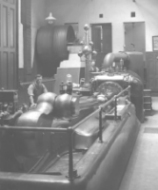A *Discount* for multiple book orders !!
Get a Quote ...- WHILE STOCKS LAST
Mills & Tall Chimneys
St. Georges Church
My Books
Mills & Tall Chimneys of Kidderminster 1850s-2010

NEW RELEASE !
- Published : March 2012
- ISBN : 978 0 9535442 4 0
- Pages : 146
SPECIAL OFFER : £10.00 (While stocks last) [UK RRP : £17.50]
The reader is taken on an illustrated journey through the town, stopping to examine the historic mills and factories of the carpet industry, past and present. Other locations are considered, including some in Stourport on Severn, together with details of the architects, the buildings and a taste of life in as typical carpet factory.
With over 500 historic photographs it is the ideal companion to Melvyn's "Woven in Kidderminster" which was launched in March 2002 and has sold 3,000 copies to all parts of the world.



Early chapters set the scene as the town converted from hand to power loom.
The architects set a standard for the towns buildings, some remain today.


Mills and factories were also built with a common theme to suit machinery of the day.
The canal network became the main transport link to all parts of the county.


Boiler houses and magnificent brick chimneys dominated the skyline.
Steam engines were the life blood of the factory with line shafting running to all parts.
During the post war expansion the early factories became unsuitable.
Building developments provided wide-span-roof buildings with good lighting and insulation.



The town changed drastically as ring-road was cut through its centre.
Whole families benefited in the swinging sixties and factory life was interesting.
Towards the Millennium the developers became hungry for land near the town centre.
The carpet industries decline provided the opportunity for new town centre retail development.



Read a BOOK REVIEW by Dr Paul Collins
Some towns are so synonymous with a particular product that their name has become a byword for it. Such was the case of Kidderminster and carpets. The industry there has been well documented before, including by Melvyn Thompson in his previous book Woven in Kidderminster (2002). However, until now, the buildings that housed the industry have been overlooked, which is great pity as, in many instances; they are all that is left as a reminder of its pivotal role in the town. Melvyn Thompson has redressed this in his latest book.
After a brief introduction to the carpet industry in Kidderminster, the book then looks at the architects, builders and foundries which made it possible, taking the story through to the recent past. Then the town is divided into eight areas and each is surveyed for all of the carpet manufacturers and factories it once accommodated. In this way 50 sites are covered, with each entry summarising the firm’s history, plus that of the site. Explanation of most of the complexes is aided by free-hand drawn sketch plans and a mix of historic and recent photographs, all too many of the latter showing dereliction and demolition.
The author brings a lifetime’s experience in the carpet industry, plus a very keen eye, to bear upon an industry as complex and intricate as some of the designs used in its products. This is a fascinating story, told with unassailable knowledge, experience and a deal of wit. Personal comments and updates augment some entries, but these are not self-indulgent, adding considerably to the story. There are also a number of quoted comments, of which this ‘Weaver’s Toast’ from 1886 – ‘May the trade of Kidderminster be trodden under foot by all nations’ – is a gem!
Melvyn Thompson would perhaps not regard himself as an Industrial Archaeologist, but in this book he has produced as good a survey of the buildings and remains of a once major industry as it has been this reviewer’s pleasure to read. That he has done so single-handed, and published the book himself, is all the more to his credit and to the chagrin of other publishers. Other than to chronicle even more losses, little remains to be added on this subject.
Dr Paul Collins
Member (Partnerships), Executive Council, Association for Industrial Archaeology


